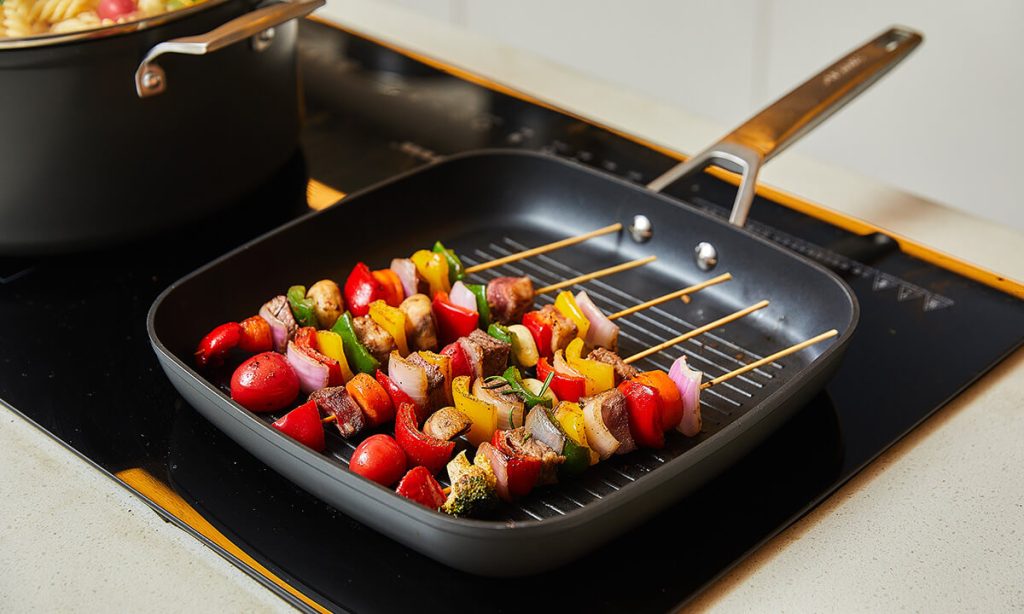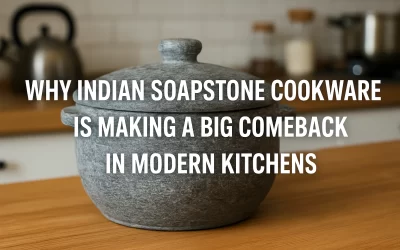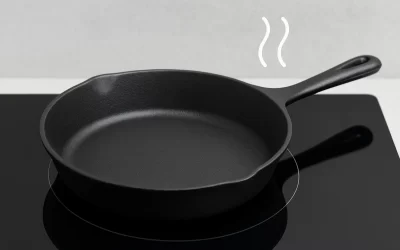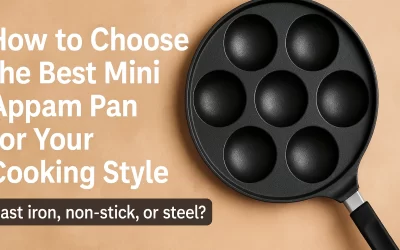The Rise of Healthy Cooking Trends Non Stick Grill Pan
Shift Toward Clean Eating

Over the past decade, there’s been a major shift toward clean eating and wellness. More people are reading nutrition labels, choosing organic produce, and avoiding deep-fried or heavily processed meals. This movement isn’t just about losing weight—it’s about feeling good and fueling the body with whole, nutritious foods.
Home Cooking as a Wellness Movement
Cooking at home has become the cornerstone of a healthy lifestyle. It gives you full control over ingredients, portions, and cooking techniques. With appliances like non-stick grill pans, even busy families can whip up healthy meals that taste like they came straight off a summer BBQ.
Why Grilling is a Healthier Cooking Option
Reduced Oil and Fat
Grilling allows excess fat to drip away from food, unlike frying which traps it. Especially when using a non-stick grill pan, you need little to no oil—making your meals naturally lower in fat and calories.
Retention of Nutrients
Unlike boiling or frying, grilling helps retain water-soluble vitamins and minerals. It locks in flavors and nutrients, especially in vegetables like bell peppers, zucchini, and asparagus.
Natural Flavor Enhancement
Grilling adds that delightful char and smoky flavor, making even the simplest vegetables taste gourmet. You don’t need heavy sauces or loads of salt—just a pinch of seasoning and some good heat.
What is a Non-Stick Grill Pan?
Materials and Design
A non-stick grill pan is typically made from cast aluminum or hard-anodized aluminum, coated with a non-stick surface like ceramic or PTFE. Raised ridges simulate grill lines and allow fat to drain away.
How It Works
Just heat the pan, place your food, and let it sear. Thanks to the non-stick surface, your ingredients cook evenly without sticking, and cleanup is quick.
Key Features to Look For
- PFOA-free coating
- Oven-safe capability
- Heat-resistant handles
- Induction compatibility
- Dishwasher-safe (optional)
Health Benefits of Using a Non-Stick Grill Pan
Less Oil, More Flavor
With a high-quality non-stick surface, you won’t need sprays or oils. This leads to fewer calories per serving and keeps natural flavors intact.
Fewer Toxins Than Traditional Pans
Modern non-stick grill pans are designed without harmful chemicals like PFOA or lead, ensuring your food remains clean and safe.
Easy Cleaning Reduces Bacterial Risk
A clean pan means less risk of food contamination. Since food doesn’t stick, there’s less residue buildup and reduced chances of bacterial growth.
Comparing Non-Stick Grill Pans to Outdoor Grills
Health Considerations
Charcoal grilling can release carcinogens if meat is burned. A grill pan eliminates this risk while still delivering seared goodness.
Convenience and Control
You can use grill pans indoors anytime, no matter the weather. They’re portable, quicker to heat, and perfect for apartments.
Cost and Maintenance
Outdoor grills require propane, cleaning, and maintenance. A non-stick grill pan is a one-time investment that pays for itself in convenience.
Best Foods to Grill for a Healthy Meal Non Stick Grill Pan
Lean Proteins
Grill skinless chicken breast, turkey cutlets, salmon, shrimp, or even tofu. These options are rich in protein and low in fat.
Fresh Vegetables
Zucchini, asparagus, eggplant, bell peppers, and even romaine lettuce grill beautifully with just a drizzle of lemon juice or balsamic vinegar.
Low-Calorie Marinades
Use olive oil, citrus juices, herbs, and spices for clean marinades. Avoid sugar-laden BBQ sauces and opt for natural flavors.
Step-by-Step Guide to Using a Non-Stick Grill Pan
Prepping the Non Stick Grill Pan
- Preheat on medium heat for 5 minutes
- Don’t use metal utensils
- Lightly brush with oil if needed
Grilling Techniques
- Don’t overcrowd the pan
- Flip only once for perfect grill marks
- Cover with a lid for faster cooking
Cleaning and Storage
- Let it cool before washing
- Use warm water and a soft sponge
- Store flat or hang to prevent scratches
Common Mistakes to Avoid
Overheating the Non Stick Grill Pan
Never preheat a non-stick pan on high heat. This can damage the coating and create fumes.
Using Metal Utensils
Stick to wooden or silicone tools to avoid scratches.
Skipping the Preheat
A cold pan can lead to uneven cooking. Always preheat before placing food on it.
Recipes for Healthy Grilled Dishes at Home with Non Stick Grill Pan
Grilled Chicken and Zucchini
- Ingredients: Chicken breast, zucchini, olive oil, garlic
- Grill until golden and serve with a yogurt dipping sauce.
Tofu and Bell Pepper Skewers
- Marinate tofu in lemon juice and herbs
- Alternate with colorful peppers on skewers
- Grill for 8–10 minutes turning halfway
Citrus-Glazed Salmon
- Glaze with orange juice, honey, and mustard
- Grill skin-side down for crispy texture

How to Choose the Right Non-Stick Grill Pan
Size and Shape
A 10- to 12-inch square pan suits most households. Choose a round one if you have limited space.
Heat Resistance and Compatibility
Ensure it works with your stovetop—especially if you have an induction cooktop.
Eco-Friendly and Non-Toxic Coatings
Opt for ceramic or titanium coatings for extra safety and environmental benefits.
Cleaning and Maintaining Your Non-Stick Grill Pan
Daily Cleaning Tips with Non Stick Grill Pan
- Use mild soap and soft sponges
- Avoid soaking for long hours
Long-Term Maintenance
- Season your pan if the brand allows
- Avoid dishwasher use unless specified
What to Avoid
- Metal scrubbing pads
- Sudden temperature changes
Top-Rated Non-Stick Grill Pans in 2024
Budget-Friendly Options
- GreenLife Ceramic Grill Pan
- T-fal Initiatives Grill Pan
Professional-Grade Pans
- Le Creuset Cast Iron Grill Pan
- All-Clad HA1 Hard Anodized Grill Pan
User Reviews and Recommendations
Consumers love models with stay-cool handles and deep ridges for better fat separation.
Environmental and Health Impacts of Non-Stick Coatings
PFOA-Free Coatings
Choose brands that advertise PFOA-free and eco-conscious manufacturing processes.
Safe Use Guidelines
Avoid overheating and always follow manufacturer instructions.
Eco-Conscious Alternatives
Ceramic and titanium-coated pans offer an earth-friendly way to grill.
Expert Tips for Healthy Grilling at Home
Flavor Without Calories
Use citrus juices, garlic, ginger, or smoked paprika to flavor without adding fats.
Seasoning and Timing
Marinate for at least 30 minutes for best results, and grill with timing precision.
Smart Shopping for Ingredients
Look for lean cuts, fresh produce, and organic or locally sourced items when possible.
FAQs About Healthy Grilling and Non-Stick Pans
Q1: Can I use olive oil on a non-stick grill pan?
Yes, but use it sparingly to preserve the coating.
Q2: Is grilling indoors safe?
Absolutely! As long as there’s proper ventilation and you’re using cookware safely.
Q3: Do non-stick pans wear out?
Yes, typically after 2–5 years depending on use. Replace once the surface wears off.
Q4: What foods stick the least?
Vegetables and fatty fish like salmon rarely stick, especially when lightly oiled.
Q5: Can I use a grill pan on an induction stove?
Yes, if the pan is induction-compatible—check the product label.
Q6: How do I store my pan safely?
Avoid stacking with heavy items and hang or place flat with a cloth in between.
Conclusion: Embracing Easy and Healthy Grilling at Home
With the right tools and a little know-how, healthy grilling at home: how a non-stick grill pan makes it easy becomes more than just a tagline—it’s your everyday reality. A non-stick grill pan gives you the flexibility to cook healthier meals quickly, clean up effortlessly, and enjoy restaurant-quality flavors without stepping outside. Whether you’re a novice cook or a culinary enthusiast, it’s time to fire up your stove and embrace a tastier, healthier lifestyle.





0 Comments